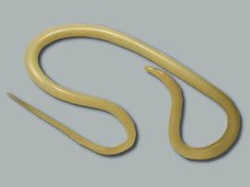
- They are cylindrical, unsegmented and triploblastic animals commonly known as round worms.
- They are mostly aquatic, but few are terrestrial.
- They are free-living as well as parasitic.
- Body is pseudo-coelomate (false coelom), derived from embryonic blastocoel and they lack peritoneal lining.
- Body is bilaterally symmetrical. A distinct head is absent, but internal cephalization is present.
- They don’t have the power of regeneration.
- Body is covered with a thick cuticle (syncytial) which is flexible, non-living and made up of scleroprotein.
- Body systems:
- Digestive system is complete with mouth and anus.
- Pharynx is muscular and highly specialized. Cloaca occurs in some forms.
- Circulatory system and respiratory system are absent.
- Protonephridia (in some forms) or Rennet cells (‘H’ shaped) or Giant cells are the excretory organs which also help in
- Sense organs are in the form of pits, papillae, bristles and eye spots. The papillae are believed to be tango-receptors (sensitive to touch) and the amphids (pits) are chemo or olfacto-receptors.
- Reproduction:
- They show sexual dimorphism (sexes are separate).
- Male is smaller than the female. In male, testis is single (monodelphic) whereas in female, a pair of ovary are present (didelphic).
- Male possesses a pair of pineal setae or spicules. The testis is thread like and the sperm is amoeboid and without a tail.
- Eggs are embryonated or mammilated with chitinous shell.
Phylum Aschelminthes or Nemathelminthes is divided into following five classes.
Class: Nematoda
- Commonly known as roundworms, they are aquatic or terrestrial.
- They may be free-living or parasitic.
- Body wall is with syncytial cuticle and longitudinal muscles in four bands.
- Digestive system is complete, with muscular pharynx and glands.
- They lack respiratory and circulatory system.
- e.g. Ascaris, Rhabtites, Oxyrius etc.
Also see Differences between Male and Female Ascaris
Class: Rotifera
- They are microscopic and aquatic animals.
- Eye spots and antennae act as sensory organs.
- They are commonly called wheel animalcules having a trunk and a tail.
- Body wall is thickened into plates or lorica.
- Anteriorly, they have a ciliated trochial disc.
- e.g. Limnias, Rotara (Rotifera) etc.
Class: Nematomorpha
- They are commonly known as hair worms, found in spring (aquatic).
- Body is unsegmented and covered with a thick cuticle.
- Pseudocoel is present which is filled with parenchyma.
- They lack circulatory, respiratory and excretory system.
- Digestive system is complete.
- e.g. Paragprdius, Nectonema etc.
Class: Gastrotricha
- They are microscopic and may be fresh water forms or marine.
- Body is covered by cuticle which bears spines.
- Excretory system consists of two protonephridia.
- Pharynx is tri-radiate and muscular.
- The posterior end of the body is forked.
- e.g. Macrodasys, Chaetonotus etc.
Class: Kinorhyncha
- They are marine, microscopic and worm like forms.
- Body is superficially segmented.
- Body surface is spherical and consists of spiny cuticle.
- e.g. Trachydemus, Echinoderes etc.